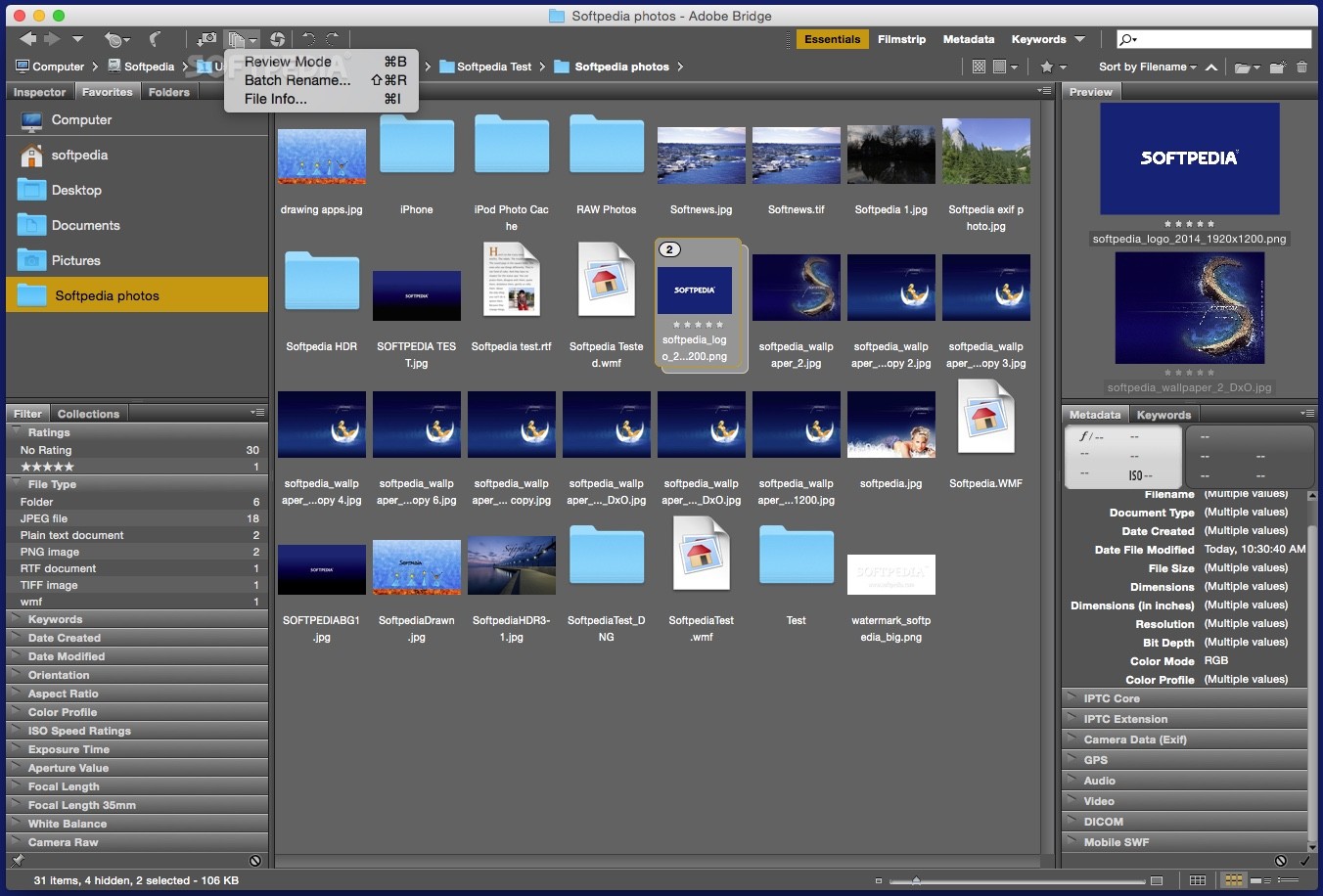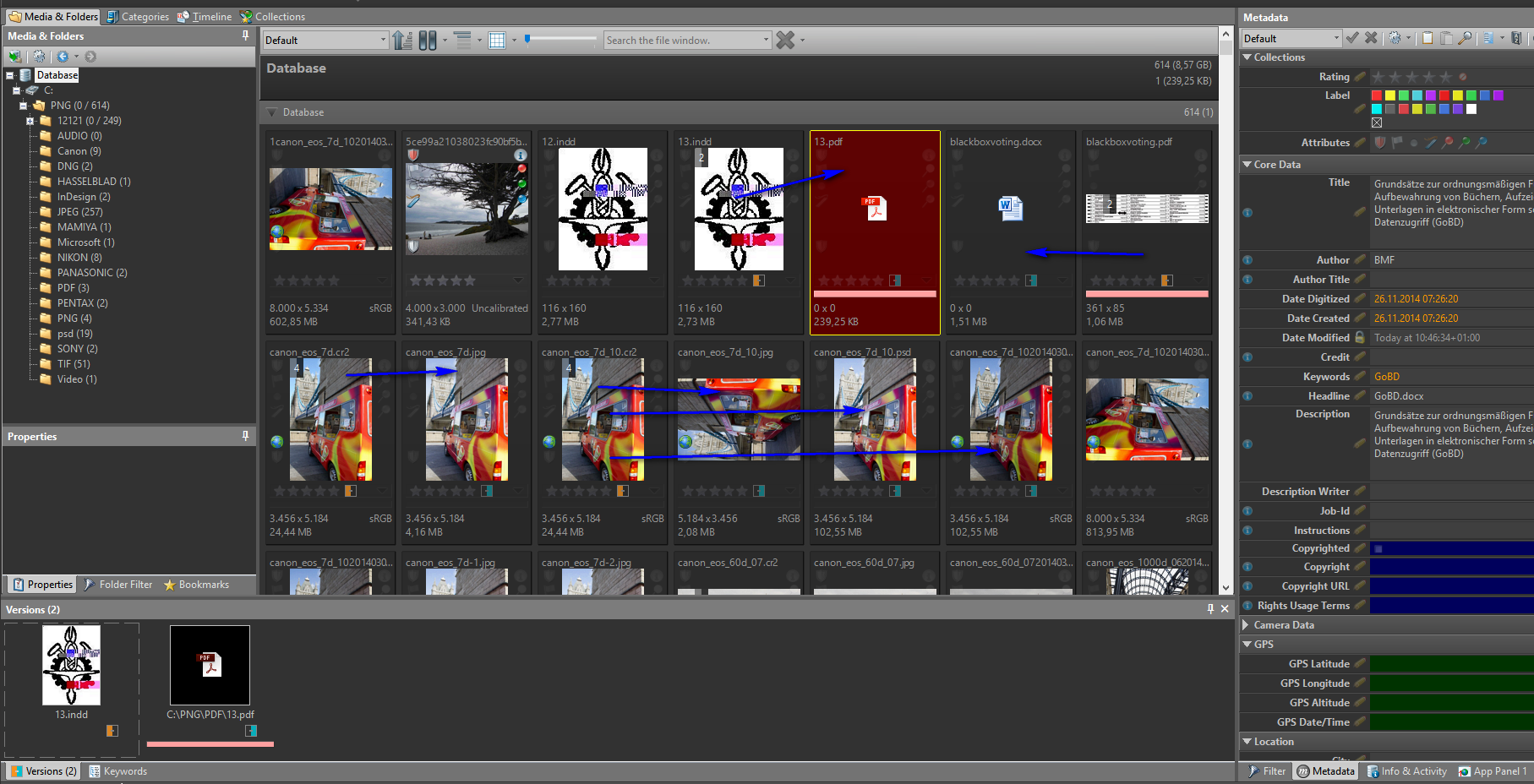Adobe Bridge is a digital asset management software. It was first released as a part of the Adobe Creative Suite 2 in 2005 and is compatible with both Windows and Mac. The primary function of Bridge is to organize a large number of files by renaming a group of them at a time. You are also provided with the option to assign colored labels and star ratings as allocated by the respective Adobe software suite.
PictureEcho follows Google Software Principles
Bridge also helps in the better organization of files by allowing you to sort and categorize the files based on the metadata. On the flip side, however, this software does not present you with editing tools such as those offered by Lightroom and Photoshop.
Adobe Bridge is a free digital asset management app made by Adobe Systems and first released with Adobe Creative Suite 2.It is a mandatory component of Adobe Creative Suite, Adobe eLearning Suite, Adobe Technical Communication Suite and Adobe Photoshop CS2 through CS6. Adobe Bridge is a companion program for Photoshop. Bridge is often referred to as a digital asset manager, or a media manager. That's because Adobe Bridge gives us powerful ways to find, manage and organize our ever-growing collection of images. In fact, Bridge isn't limited to just photos, or just Photoshop.
Adobe Bridge is an organizational program created and released by Adobe Systems as a part of the Adobe Creative Suite. Its primary purpose is to link the parts of the Creative Suite together using a format similar to the file browser found in previous versions of Adobe Photoshop. Adobe Bridge is essentially a software that organizes your files. You can tag, organize, and manage essentially any file type that can be created within the Adobe Suite. It’s a fantastic way to scan and manage files across different programs or if you’re working with a team of people. The Adobe Bridge download is available for free from Adobe.
Adobe Bridge is usually used together with other Adobe programs such as Photoshop. This speeds up the whole process as Bridge can apply Photoshop’s compatible automation plug-ins, camera raw filters and scripts on groups of images at the same time. You can also customize Bridge as per your requirements by using JavaScript. In its initial years, Bridge provided easy access to Adobe Stock Photos, which was an extensive collection of online stock photography brought together from renowned stock photo houses. This service, however, was later discontinued in 2008.
Duplicates and Similar Photos in Adobe Bridge

If you are using Bridge as a hobbyist or as a creative media professional, over a period of time you will find your computer self-engulfed with duplicates and/ or similar looking photographs. This results in a cluttered display apart from a handsome amount of storage space being wasted. Eventually, when the time comes to clean up some storage space you are forced to delete important files, while those unwanted photos continue to sit there, occupying a significant amount of storage without you realizing.
How to Search for and Delete Duplicates and Similar Photos?
It is highly necessary to periodically search for and delete duplicate/ similar photos. There are two major approaches towards doing so. The first is the manual method, in which you go through the photos manually and determine which of them are similar. This can be a very tedious and monotonous process. The other option is to use a specialized software which helps you out in detecting similar photos. Such software programs run a scan on the photos and come up with duplicates/ similar images in a very short period of time, thus saving you the hassle of going through the data yourself.
Speed up the Manual Process of Searching for Duplicates
In order to speed up the manual method, you should first rename and organize the photos according to the date they were created on. You can do so by following these steps:
- Launch Adobe Bridge and choose the folder in which you want to search for duplicates/ similar photos.
- Now click Edit | Select All.
- Next, click on Tools | Batch Rename. You will be asked to choose the criteria according to which the files should be renamed. Here you should choose the Date/Time option. Using the drop-down box you can choose the format of the date and time that should be present in the renamed files.
- Finally, in the New Filename Rename textbox, you should choose metadata and Select resolution. Once you have made all the required selections, you can click on Rename. This will organize the photos as per their date of creation. Usually, duplicate photos share the same date of creation. This way their chances of ending up next to each other will increase and you will easily be able to manually select them.
Speed up the Manual Process of Searching for Similar Photos
Similar images usually differ from each other in terms of their resolution. In order to manually detect the similar images quickly, you should try the following mechanism.
- In the menu bar click on Edit and choose Find. Here you will find the Contains textbox. Enter 1 in it.
- Now click on Find and you will be shown a list of similar images on your screen.
- In order to delete them all, click on Edit and choose Select all.
- Next, you have to right-click and choose the Move to Trash option.
Once you have determined the duplicate files either manually or through a custom software, deleting these files is a relatively easier process. Just select all the duplicate files and click on Delete. This will get rid of all those files that were either duplicates or similar to each other, thus recovering you MBs of storage space that can now be utilized elsewhere.
A natural phenomenon with storage space is that the more storage space we have, the more storage space we think we require and the quicker it gets filled up. Therefore it is advised to make it a habit to regularly perform scans for duplicate and similar photos and delete them.
| Developer(s) | Adobe Systems |
|---|---|
| Initial release | April 4, 2005; 16 years ago |
| Stable release | CC 2021 (11.0.1) / January 11, 2021; 3 months ago[1] |
| Operating system | [2]Windows, macOS |
| Platform | x64 |
| Type | Digital asset management |
| License | Freeware |
| Website | www.adobe.com/products/bridge.html |
Adobe Bridge is a free digital asset management app made by Adobe Systems and first released with Adobe Creative Suite 2. It is a mandatory component of Adobe Creative Suite, Adobe eLearning Suite, Adobe Technical Communication Suite and Adobe Photoshop CS2[3] through CS6. Starting with Creative Cloud, however, it has become an optional component downloaded via Creative Cloud subscription.
Details[edit]
Adobe Bridge is often used to organize files by renaming a group of them at once, assigning colored labels or star ratings assigned to files from the respective Adobe software suite, edit embedded or associated XMP and IPTC Information Interchange Modelmetadata, or sort or categorize them based on their metadata. It can use these options through different versions of a file that is part of an Adobe Version Cue project. However, it lacks the photo editing functions of Adobe Photoshop Lightroom, which are carried out by the Camera Raw plugin, coming with Adobe Photoshop. Image files can be shown in different sized thumbnails, slide shows or lists. Each folder, which can be bookmarked, has a cache file for speeding up rendering time of images when viewing a thumbnail. The cache can be in one central location or in individual folders.[4]
Adobe Bridge can be invoked from within all components of Creative Suite except Adobe Acrobat.[5]
Coupled with Adobe Photoshop, Bridge can execute Photoshop's compatible automation plug-ins, scripts and Adobe Camera Raw filters on a group of images. A plugin for Photoshop called Mini Bridge adds a small file browser to Photoshop, although Mini Bridge can be used only if Adobe Bridge is running in the background.

Adobe Bridge is customizable using JavaScript.[6] The Bridge scripting guide is available online as well as in paperback format.
Adobe Bridge Free Download Windows
Adobe Bridge initially allowed for access to Adobe Stock Photos, an online collection of stock photography images drawn from well-known stock photo houses.[7] The service was discontinued on April 1, 2008[8] and reactivated in 2015 by the Fotoliamicrostock-site acquisition.
Currently, the minimum system requirements are Windows 10 (version 1903) and MacOS X 10.13.[2]
See also[edit]
References[edit]
- ^'Bridge 11.0.1 is now available, APSB20-19'. Retrieved 2020-05-01.CS1 maint: discouraged parameter (link)
- ^ ab'Bridge system requirements'. Retrieved 2020-12-01.CS1 maint: discouraged parameter (link)
- ^'Adobe Bridge included with the stand-alone Adobe Photoshop'. Archived from the original on 22 February 2008. Retrieved 2008-02-29.CS1 maint: discouraged parameter (link)
- ^'The cache in Adobe Bridge'. Archived from the original on 5 April 2008. Retrieved 2008-02-29.CS1 maint: discouraged parameter (link)
- ^'Adobe Bridge is not included with the standalone version of Adobe Acrobat 8'. Archived from the original on 22 February 2008. Retrieved 2008-02-29.CS1 maint: discouraged parameter (link)
- ^'Adobe Bridge is extensively customizable using JavaScript'(PDF). Adobe Systems. Archived from the original(PDF) on 2006-08-24. Retrieved 2008-02-29.CS1 maint: discouraged parameter (link)
- ^'Adobe Stock Photos'. Retrieved 2008-02-29.CS1 maint: discouraged parameter (link)
- ^'The Adobe Stock Photos service was discontinued by Adobe on April 1st, 2008'. Archived from the original on 11 June 2008. Retrieved 2008-05-16.CS1 maint: discouraged parameter (link)
External links[edit]
| Wikimedia Commons has media related to Adobe Bridge icons. |
Adobe Bridge Free
- Adobe Bridge – official site

